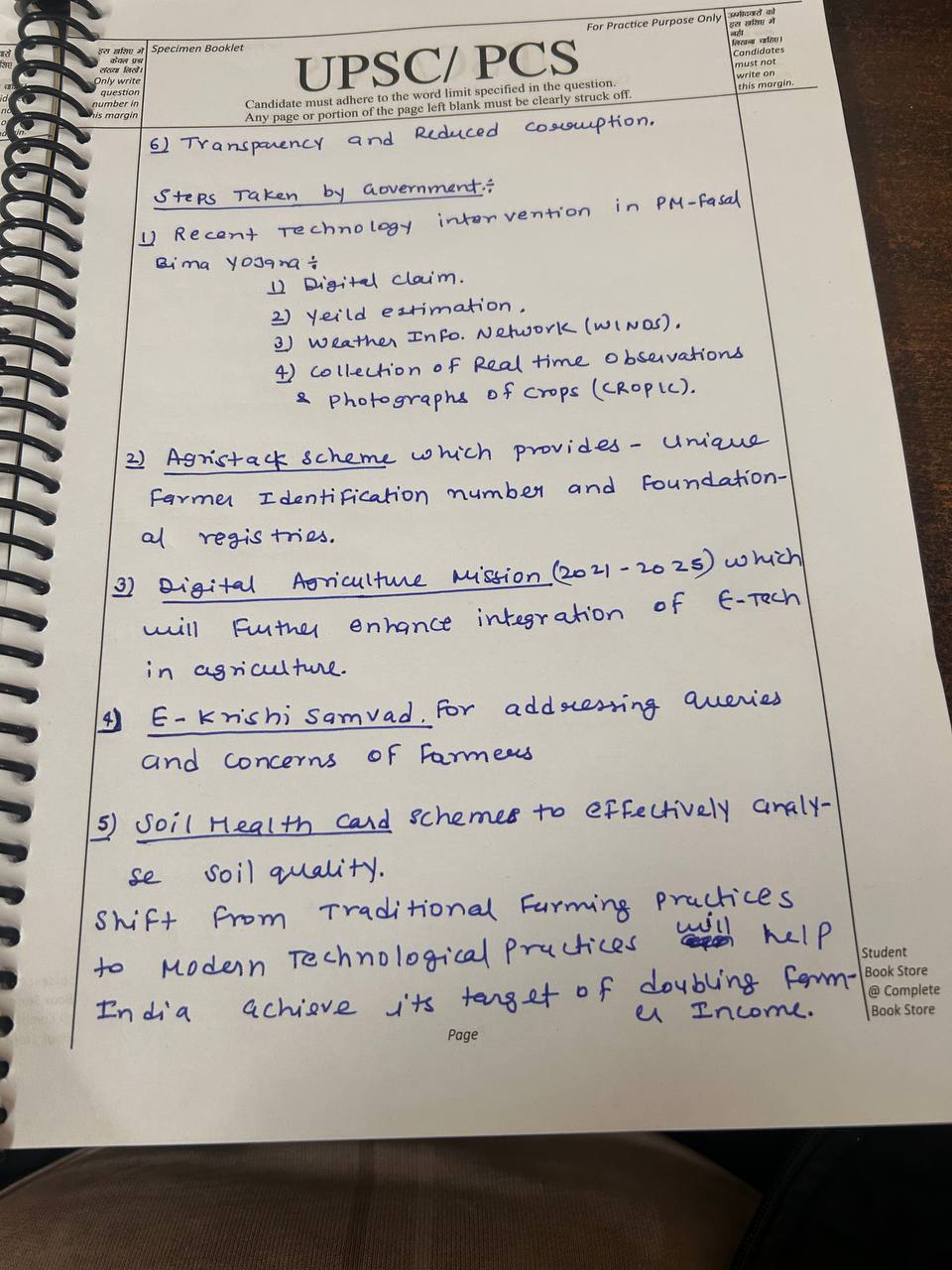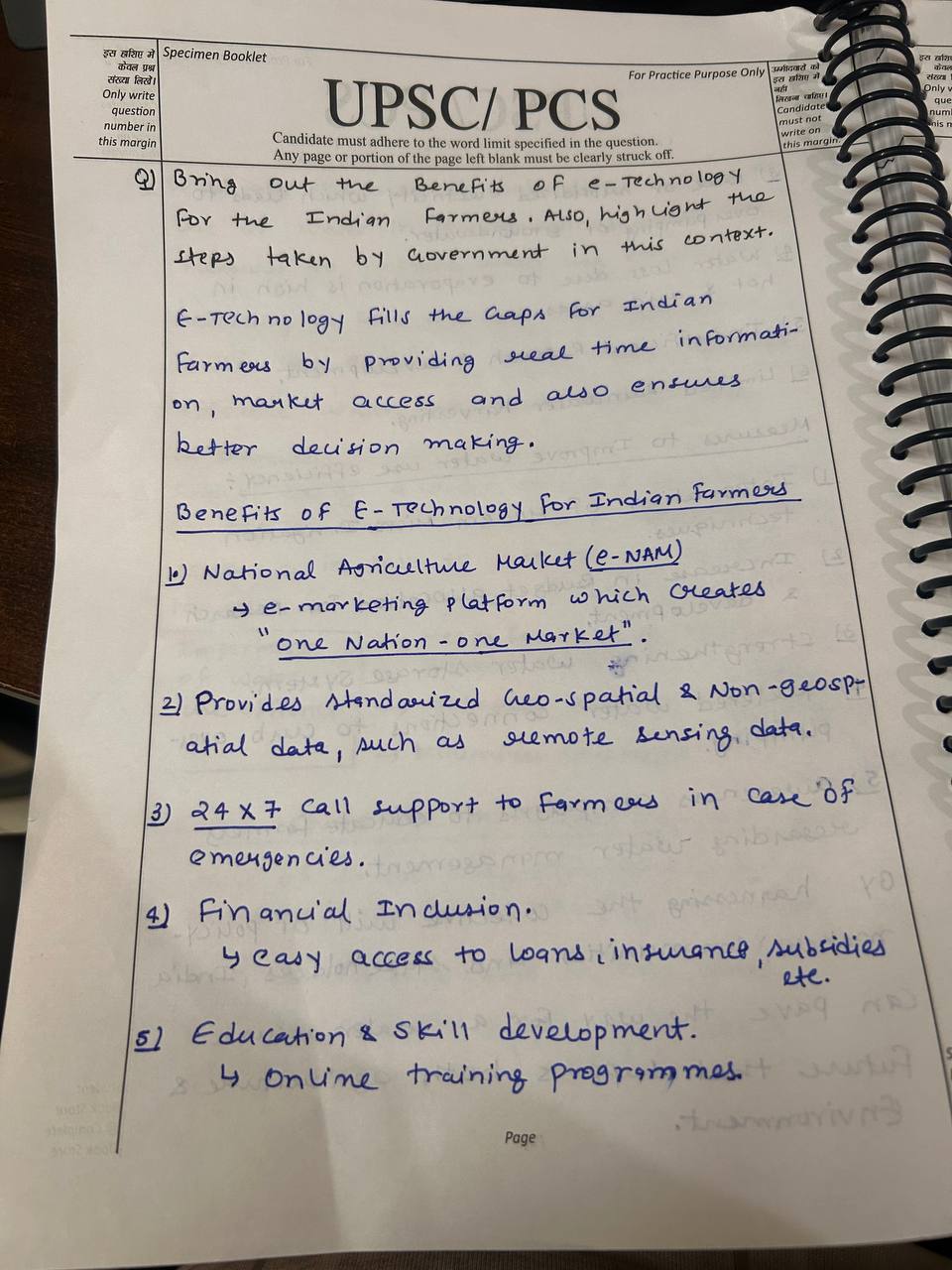Examine how artificial intelligence and big data analytics can help with risk management, decision-making, and the creation of focused interventions and policies for the agriculture industry. Also, talk about the ethical and privacy issues that come with using these technologies.
The spread of mobile technologies, remote-sensing services, and distributed computing is improving farmers' access to information, inputs, and markets, increasing production and productivity, streamlining supply chains, and reducing operational costs. According to a report by the Ministry of ElectroRead more
The spread of mobile technologies, remote-sensing services, and distributed computing is improving farmers’ access to information, inputs, and markets, increasing production and productivity, streamlining supply chains, and reducing operational costs. According to a report by the Ministry of Electronics and Information Technology and McKinsey & Company, India has a potential economic value of $50-65 billion through digital agriculture by 2025. However, there remain certain challenges in realizing the potential of digital agriculture in India. These include:
- Lack of coherent data: Machine learning algorithms require large, indexed, and standardized data sets, which are currently scarce. For example, if one is developing an early pest detection solution using an image, then a large data set of images is needed.
- Viability of technology: Digitization requires sensors, mechanization for precision farming, and connectivity, which are not viable for a majority of Indian farmers, as most of the farmers possess small and fragmented land holdings.
- Cost-benefit analysis: Precise financial estimates of the cost of technology per unit of land/ per individual farmer and corresponding savings/return on investments are not available yet in the Indian context, which makes it doubly difficult to evaluate the technology from the perspective of economic aspects.
- High capital requirement: Installation of digital technologies requires high capital cost, which would discourage its adoption among Indian farmers who remain constrained for credit.
- Inadequate investments in agricultural R&D: In 2021-22, the Department of Agricultural Research and Education was allocated Rs 8,514 crore (out of Rs.1,31,531 crore for the Ministry) of which actual expenditure fell short (-10%) of allotment.
The role PPP ecosystem is expected to play in addressing the associated challenges:
- The emergence of a start-up ecosystem: Under a PPP model for agriculture, a start-up ecosystem can drive emerging technological innovations and agile business models, while universities and research institutions can bring in domain-level agricultural expertise and help validate the solutions for scaled deployments.
- Increased productivity and profit: Studies suggest that farm-level digital advisory services can enhance productivity by 15%. There is also the potential for 40-60% of the agricultural surplus to be sold through digital marketplaces by 2025, reducing waste and helping improve farmer price realization by 10%. For instance, the E-Sahamathi initiative of Karnataka enables the sharing of agriculture and horticulture data from its database of more than 7 million farmers with start-ups/ service providers from its FRUITS (Farmer Registration and Unified Beneficiary Information System) platform.
- Convergence with public institutions: The convergence of public institutions for digital services, in partnership with start-ups and industry, will help provide the benefits of technology to smallholding farmers in order to achieve better incomes and greater sustainability thereby making Indian agriculture globally competitive and remunerative for farmers.
In this regard, the government of India 2021 launched an initiative to enable a multi-stakeholder ecosystem named IDEA (India Digital Ecosystem for Agriculture), which will open up infrastructure, data sets, academic and research expertise, and innovative policies in order to partner with a huge private ecosystem.
See less


Potential of Big Data Analytics and Artificial Intelligence in Agriculture: Decision-Making, Risk Management, and Targeted Interventions Introduction Big Data Analytics (BDA) and Artificial Intelligence (AI) offer transformative potential for the agricultural sector. These technologies can enhance dRead more
Potential of Big Data Analytics and Artificial Intelligence in Agriculture: Decision-Making, Risk Management, and Targeted Interventions
Introduction
Big Data Analytics (BDA) and Artificial Intelligence (AI) offer transformative potential for the agricultural sector. These technologies can enhance decision-making, risk management, and the development of targeted interventions and policies. However, their implementation also raises ethical and privacy concerns. This analysis explores these aspects with recent examples and discusses the associated challenges.
1. Potential of Big Data Analytics and Artificial Intelligence
a. Improving Decision-Making
Precision Agriculture: BDA and AI enable precision agriculture, which uses data-driven insights to optimize farming practices. For example, IBM’s Watson Decision Platform for Agriculture integrates weather data, IoT sensors, and AI to provide actionable insights on crop management, leading to increased yields and resource efficiency.
Crop Prediction and Planning: AI models can analyze historical weather data, soil conditions, and crop patterns to predict crop yields and plan agricultural activities. The Kisan Sabha app uses AI to provide farmers with personalized recommendations on crop selection and management based on real-time data.
b. Enhancing Risk Management
Climate and Weather Forecasting: AI algorithms analyze large volumes of climate and weather data to provide accurate forecasts and early warnings. For instance, the Indian Meteorological Department (IMD) uses AI-based models to predict extreme weather events, helping farmers prepare for and mitigate the effects of climate-related risks.
Pest and Disease Monitoring: BDA and AI can identify and predict pest infestations and plant diseases through image recognition and pattern analysis. The Plantix app, developed by PEAT, uses AI to diagnose plant diseases from photos, enabling timely intervention and reducing crop losses.
c. Development of Targeted Interventions and Policies
Tailored Extension Services: AI-driven platforms can offer personalized advice and interventions based on specific farm data. For example, Microsoft’s AI for Earth project provides farmers with data-driven insights on irrigation and soil health, helping them make informed decisions tailored to their individual needs.
Policy Formulation: Governments can use BDA to analyze agricultural trends and challenges, leading to more effective policy formulation. The Digital Green initiative utilizes data to enhance agricultural extension services and improve the delivery of policies and programs to farmers.
2. Ethical and Privacy Concerns
a. Data Privacy and Security
Data Ownership and Consent: The collection and use of agricultural data raise questions about ownership and consent. Farmers may not always be aware of how their data is used or may lack control over it. For example, data collected through apps like AgriApp must ensure that farmers’ consent is obtained and that their data is securely stored.
Data Breaches: The risk of data breaches is a significant concern. Sensitive agricultural data, if not properly protected, can be exploited or misused. Ensuring robust cybersecurity measures is crucial to protecting farmers’ data from unauthorized access and breaches.
b. Bias and Fairness
Algorithmic Bias: AI systems can perpetuate or exacerbate biases if the underlying data is skewed. For example, if training data for AI models does not adequately represent diverse farming practices or regions, the resulting recommendations may be biased, affecting certain groups unfairly.
Access Inequality: There is a risk that only large-scale or technologically advanced farmers may benefit from AI and BDA, exacerbating inequalities in the agricultural sector. Ensuring equitable access to these technologies is essential for inclusive growth.
c. Impact on Employment
Displacement of Traditional Roles: The adoption of AI and automation in agriculture may lead to the displacement of traditional farming roles. While these technologies can enhance efficiency, they may also impact employment for those who rely on traditional farming practices. Developing training and reskilling programs can help mitigate this impact.
d. Ethical Use of Data
Responsible Data Usage: The ethical use of agricultural data involves transparency in how data is collected, used, and shared. Ensuring that data practices align with ethical standards and respect farmers’ rights is vital for maintaining trust and ensuring responsible technology adoption.
3. Recommendations for Addressing Ethical and Privacy Concerns
a. Implementing Data Protection Regulations
Strengthening Policies: Enacting and enforcing data protection regulations specific to agricultural data can safeguard farmers’ privacy and ensure responsible data handling. The Personal Data Protection Bill in India, once enacted, should include provisions for agricultural data privacy and protection.
b. Ensuring Transparency and Consent
Clear Communication: Providing clear information to farmers about data collection practices and obtaining informed consent is crucial. Transparency in how data is used and how it benefits farmers helps build trust and ensures ethical practices.
c. Promoting Inclusive Access
Support for Smallholder Farmers: Initiatives should focus on making AI and BDA accessible to smallholder and marginalized farmers. Programs such as Digital Green and government subsidies for technology adoption can help bridge the digital divide and promote inclusivity.
d. Addressing Bias and Fairness
Bias Mitigation: Developing and regularly auditing AI systems to identify and address biases is essential. Engaging with diverse stakeholders and incorporating varied data sources can help ensure that AI models provide fair and unbiased recommendations.
e. Fostering Collaboration and Education
Stakeholder Collaboration: Collaboration between technology providers, government agencies, and agricultural organizations can ensure that AI and BDA solutions are developed and implemented responsibly. Educational programs and workshops can help farmers understand and leverage these technologies effectively.
Conclusion
Big Data Analytics and Artificial Intelligence hold significant promise for transforming the agricultural sector by improving decision-making, risk management, and the development of targeted interventions and policies. However, addressing ethical and privacy concerns is crucial to ensure that these technologies benefit all stakeholders while respecting their rights and maintaining fairness. By implementing robust measures and fostering responsible technology use, India can harness the full potential of BDA and AI in agriculture.
See less